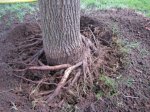I think Scott has shown us a very important technique for getting the roots to go out radially and I'm very thankful to him for sharing his experience. It's very cool to have a thread which shows a plan with detail and has the follow up to show how it's progressed. Thanks Scott!
I don't know if this belongs in another thread but given the title of Ebihara maples I think it might add a little to the discussion of getting root fusion and nice nebari. I'll give my thoughts and some pictures on a maple I have which followed a similar technique but instead of being nailed to a board it was planted over a fabric disk that doesn't let roots grow through it. I think it's the same idea.
In my opinion, roots are really only going to fuse in any meaningful way where they take off from the trunk. Out past that even if they're nicely spaced by nails they are not going to fuse. What you need to get nice nebari is restricting the roots to go sideways (which Scott has done very nicely) and having a ton of canopy growth fueling root growth (or a very long time.) If you look at my maple here I don't anticipate any fusion happening other than in the area that I outlined with triangles/square. What's going on in the periphery where I drew the radial lines is not going to fuse anytime soon. Working on where the roots are out here is just preparation for 5-15 years down the road (having better spacing perhaps.) For the next 5 yrs what matters is growing the snot out of the canopy so that the root growth makes those roots between my triangles expand in volume and fuse.
Next areas to fuse:

Areas that may be fusing many years from now but for now are just hanging out:

This is a side view of the roots growing in a plane:

As a side note the way I got this root growth was to let the canopy go unchecked from when I got the plant in spring of 2012 until I repotted in spring of 2015. The sacrifice to that is that I have some 1.5 inch sacrifice branch scars that I'm having to heal. One is closed and 2 are half closed. The canopy ended up about 12 feet across at some point. I let it escape through 2 more Anderson flats. Notice the roots are mostly on the sides. I included a shot of the fabric disk. I don't know what Chris uses for that but it feels like a synthetic woven fabric thing.
Canopy at full growth:

Escape root growth:


Roots mainly growing along sides:

Fabric disk:

Top flat:

Sacrifice branches:

I think if you train your roots to grow sideways, keep them in the same plane, and either grow it out a lot or be patient things should work out and you should end up with nice nebari. I've never tried root grafting but I'm sure that helps to fill the gaps.
Ian



















